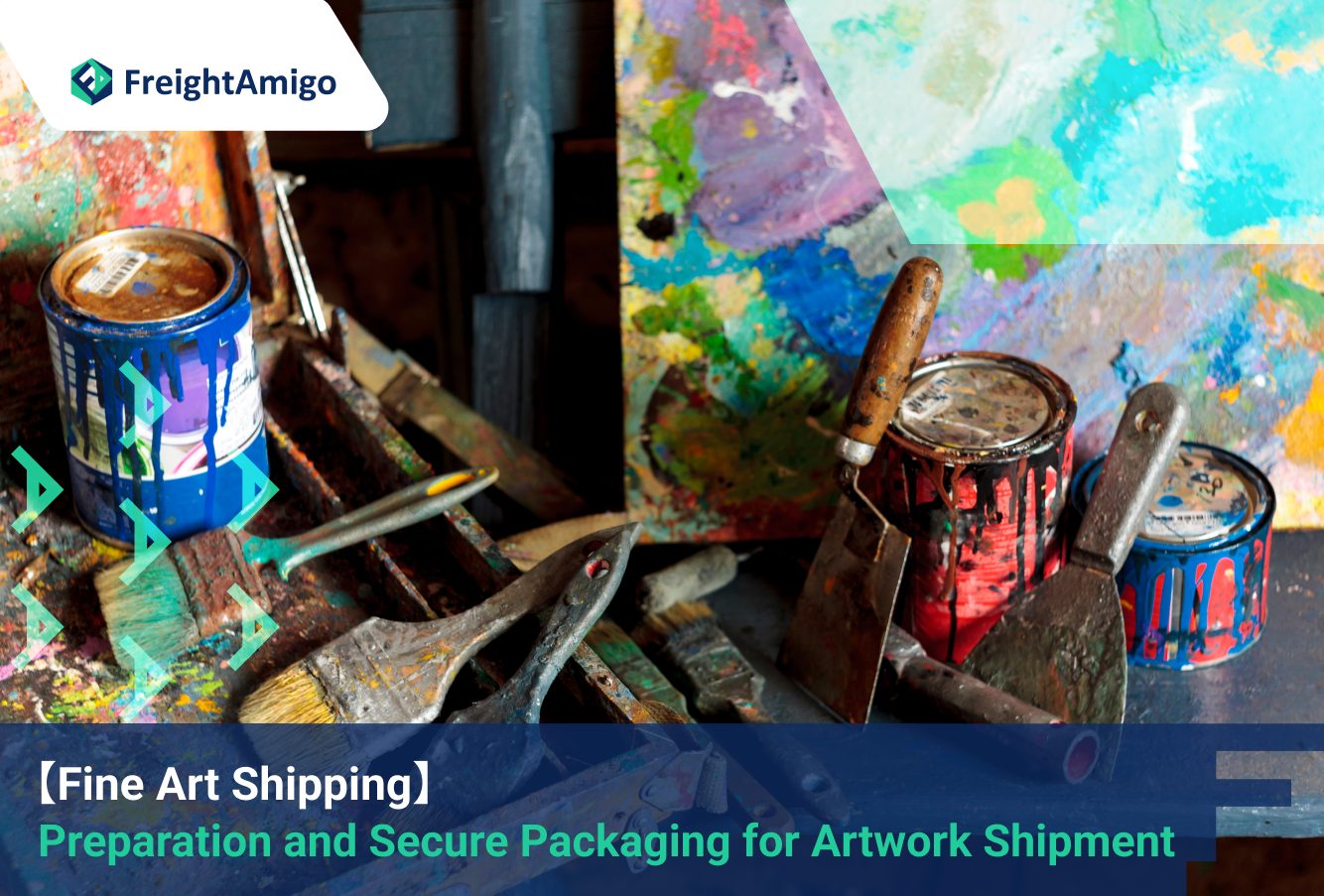As an artist or art collector, it is crucial to ensure the safe shipment of artwork. Proper packaging is essential to guarantee that your artwork arrives in pristine condition. This comprehensive guide will walk you through the crucial steps and best practices for artwork packaging. This guide will cover everything from selecting the appropriate materials to creating custom shipping boxes.
Latest update on 23 February, 2024 by Aurora Park– Marketing Analyst at FreightAmigo
Want to compare the best Express, Air Freight, Sea Freight, Rail Freight & Trucking rates so as to have better control on cost?
Introduction
Shipping artwork requires attention to detail and a well-thought-out plan. The goal is to protect valuable pieces from potential damage during transit. By following proper artwork packaging procedures, you can ensure that your artwork arrives at its destination in perfect condition.
Choosing the Right Packaging Materials
To effectively protect your artwork, it is crucial to choose the right packaging materials. Below are some essential materials you will need:
Artwork Packaging Materials Checklist:
- Cardboard Panels: These panels provide a sturdy base for creating custom shipping boxes. It is recommended to choose panels that are slightly larger than your artwork to allow for padding and protection.
- Styrofoam Boards: Opt for environmentally friendly styrofoam alternatives to protect your artwork from impact and vibrations during transit. Cut the boards to the appropriate size to fit your artwork snugly.
- Glassine Paper: Use glassine paper to protect your artwork from scratches and keep it in pristine condition.
- Plastic Sheeting: Wrap your artwork in plastic sheeting to safeguard it from moisture during shipping. To achieve maximum protection, make sure to cover the entire artwork.
- Xacto Knife: Use a sharp knife to cut materials accurately and create clean edges.
- Yardstick: A yardstick or similar tool will help you make precise measurements and create straight lines when cutting materials.
- Marker/Pen/Pencil: These tools are essential for marking measurements and guidelines during the packaging process.
- Brown Packing Tape: Use high-quality brown packing tape to secure the edges of your custom shipping box. This tape provides excellent adhesion and ensures the box remains intact during transit.
- Clear Plastic Shipping Tape: Reinforce the box by adding clear plastic shipping tape to finish off the packaging. This will add strength and stability to the box.
Preparing the Artwork for Shipment
Before you start the packaging process, it’s essential to prepare your artwork properly. Follow these steps to ensure your artwork is ready for safe shipment:
- Clean the Surface: Dust and clean the surface of your artwork using a soft, lint-free cloth. Avoid using any cleaning solutions that may damage the artwork.
- Apply Glassine Paper: To protect the artwork during transit, cover its surface with glassine paper. This will prevent scratches and keep the surface intact.
- Protect Against Moisture: Wrap the artwork with plastic sheeting, ensuring it is fully covered. This layer of protection guards your artwork against potential moisture damage during shipping.
- Add Thank You Note and Business Card: Slip in a thank you note and include your business card with the artwork. This personal touch shows appreciation to the recipient and also promotes your art and brand.
Building Custom Shipping Boxes
Creating custom shipping boxes ensures a perfect fit for your artwork and minimizes the risk of damage during transit. Follow these steps to build a sturdy and secure shipping box:
- Measure the Artwork: Measure the height, width, and depth of your artwork to determine the size of the shipping box required.
- Cut Cardboard Panels: Cut two cardboard panels slightly larger than your artwork’s dimensions. These panels will serve as the top and bottom of your custom shipping box.
- Cut Styrofoam Boards: Cut the styrofoam boards to fit the size of your artwork. These boards will provide cushioning and protection for your artwork in the shipping box.
- Mark and Score Cardboard: Mark the dimensions of the shipping box on one of the cardboard panels using a yardstick and marker. Score the lines with an Xacto knife, being careful not to cut all the way through the cardboard.
- Fold and Tape: Fold the cardboard along the scored lines to create the sides of the shipping box. Secure the edges with brown packing tape, ensuring a tight and sturdy fit.
- Add Styrofoam Boards: Place the cut styrofoam boards inside the shipping box, fitting them snugly around the artwork. These boards will provide additional protection and prevent movement during transit.
- Seal and Reinforce: Close the shipping box by folding the remaining cardboard panel over the top. Secure the edges with brown packing tape, and reinforce the box with clear plastic shipping tape.
Wrapping and Padding Techniques
To protect your artwork during transit, it is essential to use proper wrapping and padding techniques. Follow these steps to ensure that your artwork is securely padded:
- Combine Styrofoam Boards: Combine the cut styrofoam boards to cover the front and back of the artwork. Ensure that the boards fit snuggly to provide optimal protection.
- Add Padding Around the Frame: Make sure the boards fit snugly to provide optimal protection. Then, add padding around the frame. Add padding around the artwork frame, leaving at least one to two inches of space to prevent any direct impact on the fragile frame during transit.
- Use Corner Protectors: If available, use corner protectors to add an extra layer of protection to the artwork’s vulnerable corners. Alternatively, increase the padding around the corners to safeguard against any potential damage.
- Secure the Wrapping: To secure the wrapping and padding in place, use clear plastic shipping tape. Make sure that the layers are tightly secured to prevent any shifting during transit.
- Check for Snug Fit: Before placing the artwork in the custom shipping box, double-check that the wrapping and padding provide a snug fit. This snug fit minimizes movement and reduces the risk of damage.
Securing Delicate Artwork
Delicate artwork requires additional precautions to ensure its safe shipment. Follow these tips for securing delicate artwork:
- Double Boxing: For highly delicate artwork, consider double boxing. Place the wrapped and padded artwork into one shipping box, then place that box into a slightly larger box with additional padding for added protection.
- Crating: If you’re shipping extremely valuable or oversized artwork, consider using a specialized art crate. These crates provide the highest level of protection and are custom-built to fit your artwork snugly.
- Custom Foam Inserts: For delicate sculptures or three-dimensional artwork, custom foam inserts can provide an extra layer of protection. These inserts are designed to fit the contours of your artwork and minimize movement during transit.
- Fragile Stickers: Clearly label your package as “Fragile” to alert shipping carriers and handlers to exercise extra caution when handling your delicate artwork.
Labeling and Documentation
To ensure your artwork is handled correctly and reaches its intended destination, it is important to label and document it properly. Follow these guidelines:
- Clearly Label the Package: Bold and legible labels should be used to indicate that the package contains artwork and should be handled with care. The label should include your name, address, and contact information.
- Include Handling Instructions: Clearly state any specific handling instructions on the package, such as “This Side Up” or “Do Not Stack.” These instructions provide additional guidance to shipping carriers and handlers.
- Packaging Slip: A packaging slip should be included inside the package. The slip should detail the artwork’s description, dimensions, and any special instructions for handling and unpacking.
- Photograph the Package: Take a photo of the fully packaged artwork, including the labels and documentation. This will serve as visual evidence of the package’s condition before shipping.
International Artwork Shipping Considerations
Shipping artwork internationally requires additional considerations due to customs regulations and potential transportation challenges. Keep the following in mind for international artwork shipments:
- Customs Documentation: To comply with customs requirements in the destination country, research and prepare the necessary customs documentation. This should include a detailed description of the artwork, its value, and any required permits or certificates.
- Restricted or Prohibited Items: Check the regulations of the destination country regarding the import of artwork. Some countries may have restrictions on certain types of artwork or materials. Ensure compliance to avoid any customs issues.
- Packaging for International Shipment: International shipments may take longer and be handled more frequently. When shipping artwork internationally, take extra care in packaging to ensure it can withstand the journey.
- Customs Brokerage Services: To navigate the complexities of international customs procedures, it is recommended to consider using a customs brokerage service. These services can assist with documentation, customs duties, taxes, and ensure smooth clearance of your artwork.
Conclusion
Proper packaging is crucial for safely shipping artwork. Follow the steps in this guide to ensure your valuable artwork arrives at its destination undamaged. Choose appropriate packaging materials, prepare your artwork correctly, and select a reliable shipping carrier. With careful planning and attention to detail, you can confidently ship your artwork worldwide, knowing it is protected throughout the journey.
Now you have the knowledge and tools to package your artwork securely. It’s time to showcase your talent and share your creations with the world. Shipping artwork with confidence opens endless possibilities for exhibiting, selling, and collecting art. Whether you’re a professional artist or an art enthusiast, this is an opportunity not to be missed.
There are different options for cargo transportation. If you want to choose the most convenient and suitable solution, it is best to have the full support of logistics experts! If you are planning to import fine art, please go to the FreightAmigo page for inquiries.
Read More:
Fine Art Transport Insurance | Mitigating Risks | FreightAmigo
Art Installation Guide | Unpacking and Installing Artworks | FreightAmigo
Fine Art Storage | Best Practices for Preserving Artwork | FreightAmigo
If you have any inquiries on logistics/supply chain, feel free to contact FreightAmigo now:
Chat with us online | Hotline: +852 28121686 | WhatsApp: +852 27467829









































